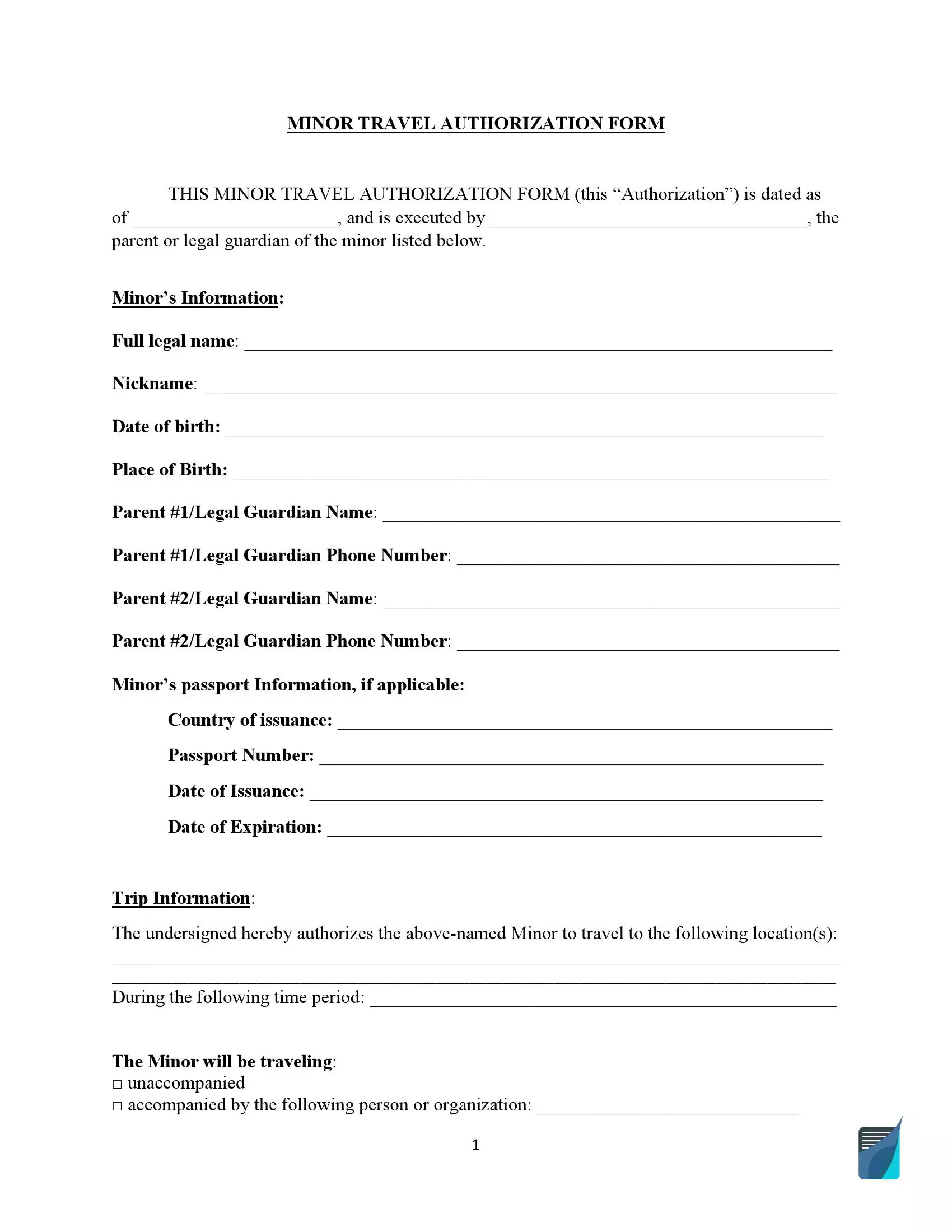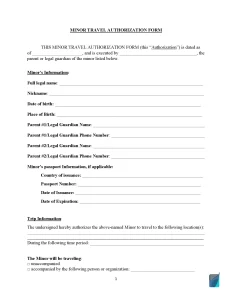Child Travel Consent Form
When you’re planning your trip with kids or a situation requiring sending your minor child abroad without you, it is recommended to prepare a child travel consent form. When a kid goes on a trip without a parent or legal guardian, migration officers can require to show a letter of consent.
This document is a preventive measure against an increasing number of child abduction cases, so customs can ask you to clarify the situation even if you’re a single parent. To ensure that the travel will not be halted or withdrawn, it is better to create a travel permission letter beforehand. You are encouraged to use our free child travel consent template to obtain your unique document in minutes.

Build Your Document
Answer a few simple questions to make your document in minutes
Save and Print
Save progress and finish on any device, download and print anytime
Sign and Use
Your valid, lawyer-approved document is ready
What Is a Child Travel Consent Form?
A travel child consent form is a document you can use as proof of permission from a lawful parent or legal guardian for a minor to travel without their presence. A parental consent form comes in handy when an adult accompanies a minor without legal authority over a child or when one of the parents is absent.
Although there is no mandatory rule that the child consent form must be notarized, when the child is to travel abroad without one of the parents, both parents, or accompanied by a non-legal caretaker, U.S. customs can demand the notarized document that validates the guardian’s right to travel with a child.
Why Consent Form Is a Must for a Trip with a Minor?
Undoubtedly, it may be an unpleasant surprise when the immigration officer requests the child travel consent form from you, but this document protects your child from being abducted and trafficked. U.S. Customs and Border Protection (CBP) recommends having consent to travel for both domestic and international travel. It can be handy if you and your child won’t have the same surname for school trips or sports events.
Domestic rules (within the US)
There are no explicitly strict rules regarding minors traveling between states within the USA. Usually, there is no need for a parental consent form if the child travels within the state or country by car, bus, or train, besides the cases when the court restricts the ability to travel. For example, after the divorce, the court may forbid a child to travel with a parent without another parent’s consent.
Moreover, airlines can require check-in documents and a consent letter for traveling.
Consider the child is about to go on a cruise with their grandparents. Should the grandparents bring travel consent letters? It depends on the type of cruise they’re about to take. You are highly encouraged to clarify this information with the travel agency or cruise staff in most cases. A child travel consent form will be required for traveling abroad, including air, land, and cruise.
Royal Caribbean Parental Consent Form – used to provide legal guardian permission for a child to travel on a Royal Caribbean cruise ship.
NCL Parental Consent Form – used by parents to provide consent for their children to participate in Norwegian Cruise Line activities. This form must be completed and signed by a parent or legal guardian prior to the child participating in any activity.
International rules
International travel requirements for children traveling can differ from country to country, so you’re strongly encouraged to check entry requirements from the embassy. In some cases, you will need a child travel consent template translated into the local language and notarized.
The child travels with a non-parental guardian. A travel child consent form is required if people who accompany a minor during vacation or travel are not their legal guardians. For example, during a school trip, tournaments, or sports event, the responsibility for the child lies on the adult who travels with them.
Usually, the parent or guardian will have to provide a child travel consent form for a school trip or if the child travels abroad with a friend of a family, family members, grandparents, or other adults who don’t possess parental authority.
The child travels with only one parent. Many parents can be pretty bewildered by the fact that their presence is not enough for crossing the border with their child. However, there are many situations of parental kidnapping where one parent takes a child abroad after a divorce or separation and thus violates the other parent’s custodial rights.
To prevent it, the U.S. customs verify if both parents are acknowledged and agree for the child to go abroad. A travel child consent form is a document that a parent must have if traveling alone with their kid, regardless of their marital status.
You need to get written permission from a second parent even if you’re divorced, were never married, or have shared custody over the child. Every non-accompanying person who obtains custody rights or parental authority over the minor must sign the child travel consent form.
Thus, be sure you have a valid child travel consent signed by the other parent. If you have sole custody, make sure you carry the notarized legal custody documents proving it for travel.
Main Components of the Child Travel Consent Form
Even though this form is rarely required for travel within the US, foreign officials can be vigilant regarding its content and deny the form if it’s filled out incorrectly. You can be asked to show the travel consent form both when you’re crossing the border of the US (leaving or returning to the state) and entering a foreign territory.
The US government doesn’t offer a common template for child travel consent. Make sure the child travel consent form is made properly and includes all the details listed below:
- Child Information. You need to write down the minor’s full name, date and place of birth, and their US passport number or foreign passport number.
- Accompanying Person. Then, you need to list down all information regarding the person you give permission for a journey with the child, their passport information, and full name.
- Contact Information. You need to provide information regarding the travel—the destination country and place of residence (full address). Make sure to clarify who the minor child will reside with and the supposed return date.
- Signature. The minor child consent form must be written on behalf of the custodial, noncustodial parent, or legal guardian and be signed by them in the presence of witnesses.
If you need a template for parental permission, you can find a free child travel consent form on our website.

How to Fill Out The Minor Travel Consent Form
Now, when you know the essentials that must be included in the travel consent for a minor, it’s time to fill out the template. If you’re afraid to make a mistake, here is a quick guide to follow.
Step 1. State the date of completing the document
In the first section, you need to indicate the date when the document is signed and completed and the document’s author (parent or legal guardian).

Step 2. Clarify the minor’s information
Provide the basic information about the child who is traveling. The details that must be included in the document are as follows:
- Full Legal Name
- Nickname
- Date of Birth
- Place of Birth

Step 3. Indicate the guardian’s or parent’s information
You need to provide valid contact information of parents or guardians. It is required to get consent from all legal representatives of a child. So, if the child travels without parents, both of them must provide their contact information. You’ll have to write in the full name of the guardian and their phone number.

Step 4. Type in passport details (optional)
If the child has a passport, it’s also required to type in the passport information providing the following details:
- Country of Issuance
- Passport Number
- Date of Issuance
- Date of Expiration

Step 5. Clarify the trip details
It is also essential to indicate the places and locations that a parent allows their child to visit. It includes countries, cities, and location addresses. The document is time-restricted, so you need to indicate the period of travel during which the document is valid.

Step 6. Indicate if the minor is accompanied
The minor can travel alone or accompanied by the individual or organization. In the latter case, provide the name of the person who will accompany the minor.

Step 7. Sign the document
Last but not least, parents or guardians must sign the document. Both parents’ or guardians’ signatures are required.

Frequently Asked Questions
Does the minor travel consent form include medical consent?
No, this type of document is only valid for authorizing a child’s domestic and international travels without a legal guardian. To secure yourself from unexpected events and emergencies, you need to additionally prepare a child medical consent form or power of attorney for guardianship.
Do grandparents require a consent letter?
Yes, any relative who is not a legal guardian or parent can be asked to demonstrate a parental permission letter for child travel if about to pass state borders. However, if it’s domestic travel or an all-around cruise, the consent form is usually not required. It’s better to verify in the respective travel agency, airline, or cruise services if any specific documents are required.
Is notarization needed for a child travel consent form?
There is no clear and hard rule for the notarization of the document. We recommend the child travel consent form be notarized to prevent issues on the border or questions regarding the document’s credibility. The best way to receive precise information regarding the requirements is at the embassy of the visiting country. In some cases, a certified translation of the form is also needed.
Make sure that your travel consent letter is signed in the presence of a witness. It can be anyone older than 19, but you’re encouraged to have a letter signed by a notary public. You can also ask for more details from the transport company you use to check the policies concerning traveling with a minor.
Do I need a child travel consent form for domestic travel?
For domestic trips with a child, you won’t need to obtain a child travel consent form from another parent to travel with a child.